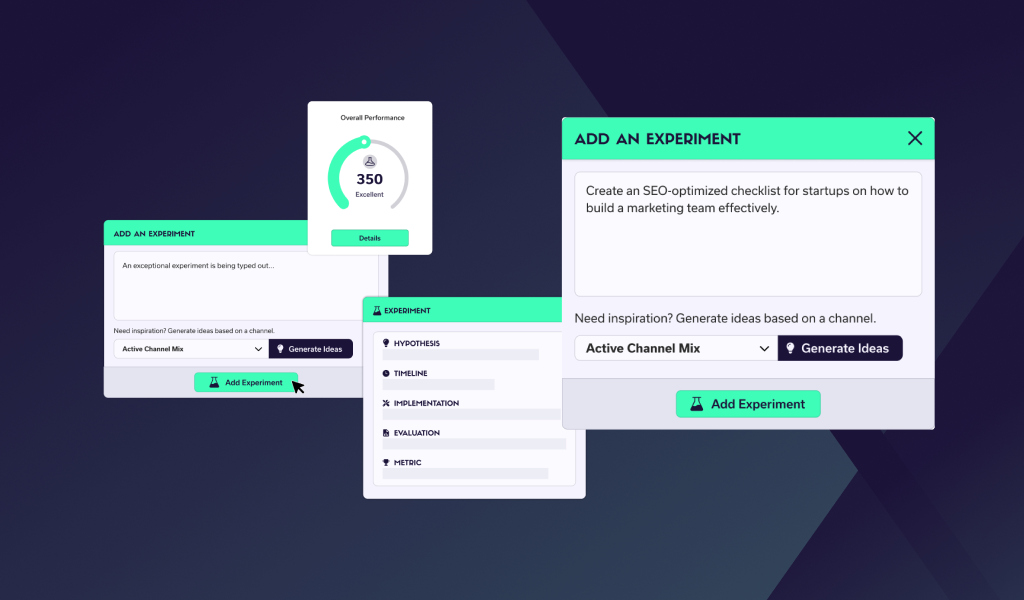Growth marketing has become an essential strategy for businesses looking to expand their reach and increase their revenue. In this article, we will delve into the key principles and elements of a growth marketing framework, as well as its relationship with data, product development, and evaluation. By the end, you'll have a solid grasp of growth marketing and how it can propel your business forward.
Defining Growth Marketing
Growth marketing is a holistic approach to Growth marketing that focuses on driving sustainable growth for a business through continuous experimentation, data analysis, and the optimisation of key metrics. Unlike traditional marketing, which often relies on fixed strategies and channels, growth marketing embraces agility and adaptability. It involves constantly testing and refining different tactics to find the most effective ways to acquire and retain customers.
When it comes to growth marketing, it's important to understand that it's not just about increasing revenue or expanding market share. It's about creating long-term value for both the business and its customers. By prioritising sustainable growth, businesses can build a loyal customer base, increase customer lifetime value, and ultimately, achieve long-term success.
The Importance of Growth Marketing in Today's Business Landscape
In today's highly competitive business landscape, it's not enough to rely solely on traditional marketing methods. With rapidly evolving consumer behaviours and preferences, businesses need to adopt a growth marketing mindset to stay ahead of the curve.
One of the key reasons why growth marketing is so important is because it allows businesses to adapt to changing market conditions. By constantly testing and refining strategies, businesses can quickly identify what works and what doesn't, allowing them to pivot and adjust their approach accordingly. This agility is crucial in an era where consumer preferences can change overnight.
Furthermore, growth marketing enables businesses to discover untapped audiences and unlock new opportunities. By leveraging data and analytics, businesses can gain valuable insights into their target market, identify niche segments, and tailor their marketing efforts to reach these specific audiences. This targeted approach not only increases the effectiveness of marketing campaigns but also helps businesses stand out in a crowded marketplace.
Key Components of Growth Marketing
At the heart of any successful growth marketing framework are several key components:
- Data-driven decision making: Growth marketing relies heavily on data to make informed decisions. By analysing user behaviour and performance metrics, growth marketers can identify areas for improvement and prioritise their efforts accordingly.
- Iterative experimentation: Growth marketing requires a mindset of continuous experimentation. By testing different hypotheses and approaches, businesses can uncover valuable insights and refine their strategies for optimal results.
- Customer acquisition and retention: Finding new customers is just the beginning. Growth marketing puts equal emphasis on retaining existing customers by using personalised messaging, targeted campaigns, and ongoing customer support.
- Cross-functional collaboration: Successful growth marketing involves collaboration between various departments, including marketing, product development, data analysis, and customer support. By breaking down silos and fostering a shared vision, businesses can create a seamless customer experience.
These components work together to create a comprehensive growth marketing strategy that focusses on both short-term wins and long-term success. By constantly analysing data, experimenting with different tactics, and collaborating across departments, businesses can drive sustainable growth and stay ahead in today's dynamic business landscape.
It's worth noting that growth marketing is not a one-size-fits-all approach. Each business is unique, and what works for one may not work for another. Therefore, it's important for businesses to tailor their growth marketing strategies to their specific industry, target audience, and business goals. This customisation ensures that businesses can maximise their marketing efforts and achieve the best possible results.
The Role of Data in Growth Marketing
Data is the lifeblood of growth marketing. It provides invaluable insights into user behaviour, market trends, and the effectiveness of marketing campaigns. Here are two key ways data drives decision-making in growth marketing:
How Data Drives Decision-Making in Growth Marketing
Data allows growth marketers to make informed decisions about where to allocate resources and which strategies to prioritise. By leveraging data analytics tools, businesses can track the performance of various marketing channels, measure customer engagement, and identify areas for improvement. This data-driven approach ensures that growth efforts are backed by solid evidence and yield measurable results.
For example, let's consider a growth marketing team that is responsible for promoting a new mobile app. By analysing data on user acquisition channels, they can determine which channels are driving the most downloads and user engagement. If they find that social media advertising is generating the highest number of downloads, they can allocate more resources to that channel and optimise their campaigns to further enhance their reach and impact.
Data also allows growth marketers to identify trends and patterns in user behaviour. By analysing data on user interactions with a website or app, marketers can gain insights into which features or content are most popular and engaging. This information can then be used to inform future marketing strategies and content creation efforts, ensuring that the business is consistently delivering what its target audience wants and needs.
Leveraging Data for Customer Acquisition and Retention
Using data, growth marketers can gain a deep understanding of their target audience. By analysing customer demographics, preferences, and purchase patterns, businesses can tailor their marketing messages to resonate with specific customer segments. Additionally, data can help identify potential churn risks and enable businesses to implement proactive retention strategies, such as personalised offers or loyalty programmes.
For instance, imagine a growth marketing team working for an e-commerce company. By analysing data on customer demographics and purchase history, they can identify different customer segments with varying preferences and behaviours. Armed with this information, the team can create targeted marketing campaigns that speak directly to each segment's unique needs and desires. By personalising the messaging and offers, they can increase customer acquisition and retention rates, ultimately driving growth for the business.
Data can also be used to predict customer churn and implement proactive strategies to prevent it. By analysing data on customer engagement, purchase frequency, and interactions with customer support, businesses can identify customers who may be at risk of leaving. Armed with this knowledge, growth marketers can design targeted retention campaigns, offering personalised incentives or exclusive offers to keep these customers engaged and loyal.
In conclusion, data plays a crucial role in growth marketing. It empowers marketers to make informed decisions, optimise strategies, and personalise their approach to customer acquisition and retention. By harnessing the power of data analytics, businesses can drive sustainable growth and stay ahead in today's competitive market.
Building a Successful Growth Marketing Strategy
Building a successful growth marketing strategy requires careful planning and a deep understanding of your business objectives and target audience. Here are two key steps to get started:
Setting Measurable Goals for Growth
Before diving into growth marketing initiatives, you need to establish clear, measurable goals. Whether it's increasing website traffic by a certain percentage or boosting product sign-ups, setting specific targets will serve as a guiding force for your growth efforts. Monitor and track your progress regularly to ensure you're on the right path.
Identifying and Understanding Your Target Audience
To effectively reach your audience, you need to know who they are and what they want. Conduct market research and analyse user data to gain insights into your target audience's demographics, behaviours, and pain points. This information will help you craft tailored messages and select the most relevant marketing channels for maximum impact.
The Relationship Between Growth Marketing and Product Development
Growth marketing and product development go hand in hand. Here's how growth marketing can influence product design:
How Growth Marketing Influences Product Design
By closely monitoring customer feedback and data insights, growth marketers can identify areas of improvement or new features to incorporate into a product or service. This iterative approach allows companies to build products that align with customer needs and preferences, increasing the likelihood of customer satisfaction and long-term loyalty.
The Role of Product Development in Customer Retention
A robust product development process is essential for customer retention. By continuously enhancing and updating your offerings based on customer feedback and market trends, you can ensure that your product remains relevant and valuable to your target audience. This strengthens customer loyalty and reduces the likelihood of churn.
Evaluating the Success of Your Growth Marketing Framework
To assess the effectiveness of your growth marketing efforts, you need to establish key performance indicators (KPIs). Here are two important factors to consider:
Key Performance Indicators for Growth Marketing
Common KPIs for growth marketing include conversion rates, customer acquisition cost (CAC), customer lifetime value (CLTV), and user engagement metrics. By regularly tracking these metrics, businesses can measure the impact of their growth marketing initiatives and make data-driven adjustments to optimise performance.
Continuous Improvement and Adaptation in Growth Marketing
Growth marketing is not a one-time endeavour but an ongoing process of learning and adapting. By continuously monitoring performance, analysing data, and experimenting with different strategies, businesses can stay ahead of the competition and achieve sustainable growth. Remember to regularly review your growth marketing framework and make adjustments as needed.
In conclusion, understanding the basics of a growth marketing framework is crucial for businesses looking to thrive in today's dynamic marketplace. By embracing the principles of growth marketing, leveraging data, building a solid strategy, and evaluating performance, you can unleash your business's full potential and achieve sustainable growth. Keep evolving and adapting, and success will follow.
Talk to a Growth Advisor
We create a clear, focused marketing strategy by combining our expertise with your knowledge of your business.
Trusted by over 130 startups because our unique growth process and team of marketing experts unlock exponential growth











